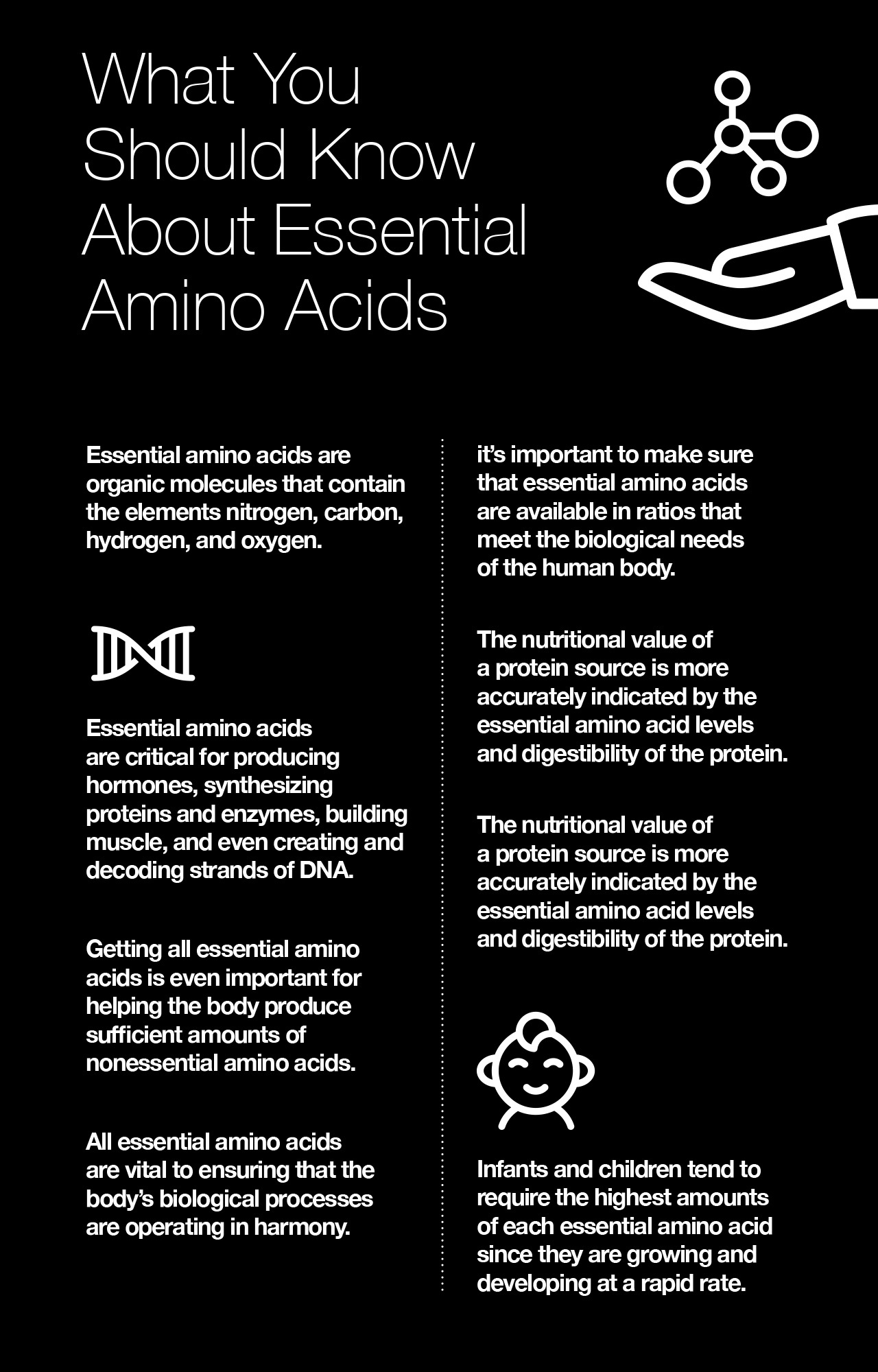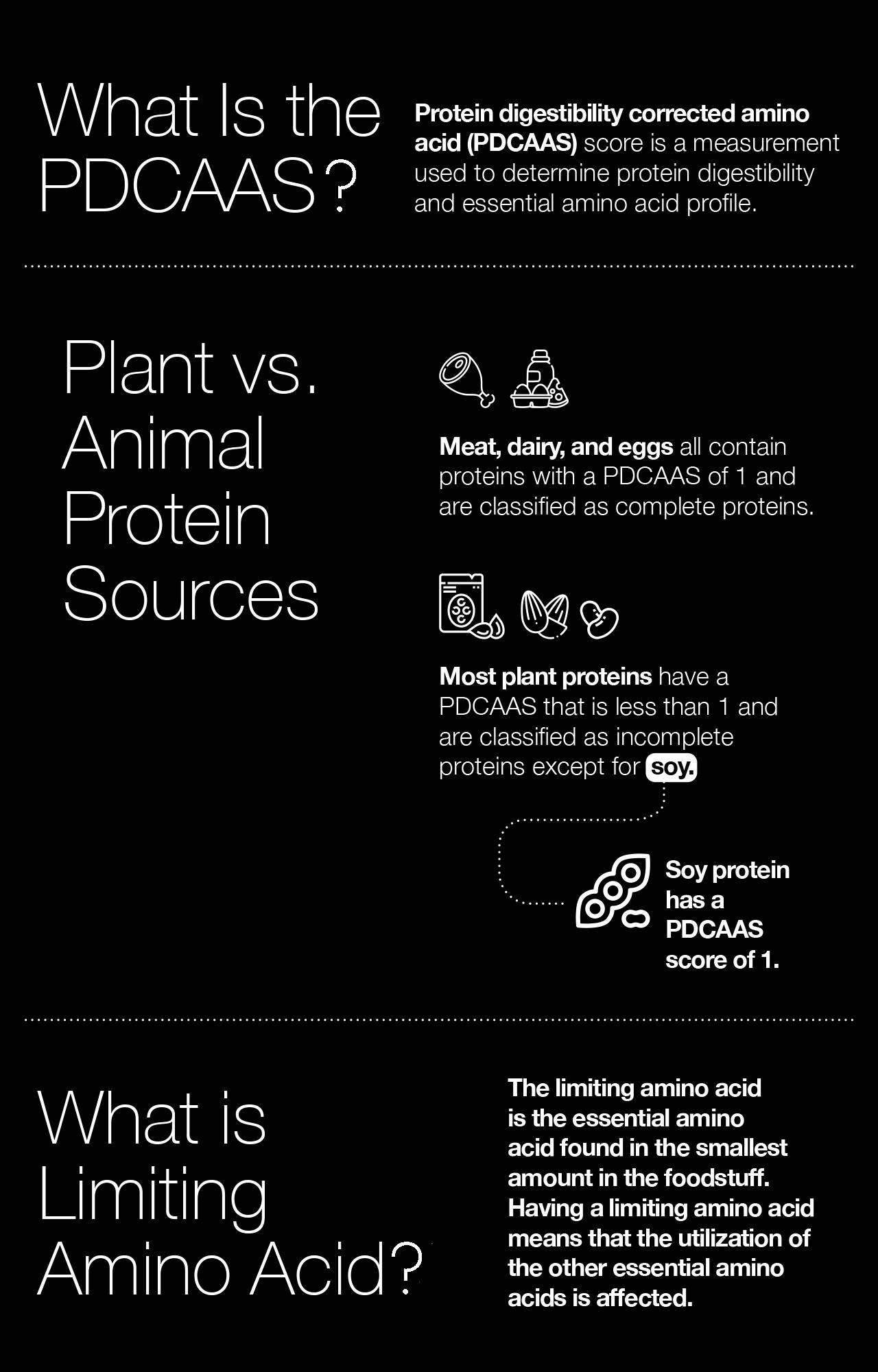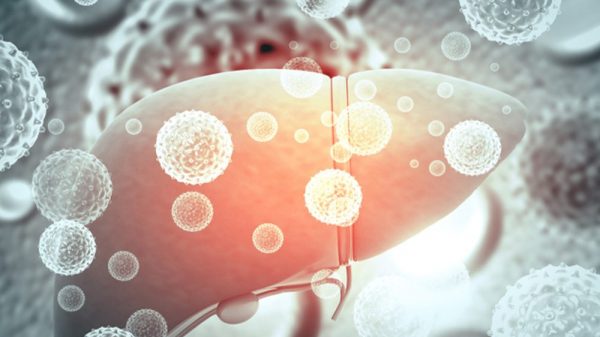Essential amino acids are fundamental to supporting optimal health. They are the smallest building blocks of protein and we must consume them through the foods we eat. In contrast to nonessential amino acids, which can be synthesized from other materials internally through metabolic processes, essential amino acids must be ingested from dietary sources. We need them for nearly all biological processes. Here we examine why essential amino acids are indispensable to our health, and how the limiting amino acid plays a role in regulating amino acid utilization in the body.
What Are Essential Amino Acids and Why Do We Need Them?
Essential amino acids are organic molecules that contain the elements nitrogen, carbon, hydrogen, and oxygen. They contain similarities in their structure – all contain carboxyl and amine groups that are attached to a central carbon atom. The distinguishing component of each essential amino acid is the composition of the R-group or sidechain that is also attached to the central carbon atom.
The nine essential amino acids that the body requires include histidine, threonine, methionine, lysine, leucine, isoleucine, valine, phenylalanine, and tryptophan.
Structural parallels can be drawn across certain essential amino acids. For example, leucine, isoleucine, and valine are grouped together as branched-chain amino acids (BCAA) because of their characteristic side chains, which contain carbon groups attached to the central carbon in a branch-like configuration. Phenylalanine, histidine, and tryptophan are known as aromatic amino acids since their R groups contain ring structures attached to the central carbon atom.
These essential amino acids are the smallest individual units of protein and are utilized in nearly all biological functions. Essential amino acids are critical for producing hormones, synthesizing proteins and enzymes, building muscle, and even creating and decoding strands of DNA. Getting all essential amino acids is even important for helping the body produce sufficient amounts of nonessential amino acids.

We Require Optimal Ratios of Essential Amino Acids
Not just any ratio of essential amino acids will promote healthy functioning. Instead, it’s important to make sure that essential amino acids are available in ratios that meet the biological needs of the human body.
There are also biological functions that require different essential amino acids. For example, tryptophan and phenylalanine are vital for producing neurotransmitters. Tryptophan is a building block of serotonin, which helps regulate sleep and mood. Phenylalanine, though not a direct starting material, is vital in the production of neurotransmitters like dopamine and norepinephrine, which regulate feelings of contentedness, reward, motivation, and mental energy. Getting enough tryptophan and phenylalanine is critical for supporting optimal cognitive function, mood, and concentration. On the other hand, essential amino acids like the methionine amino acid and lysine amino acid are critical for healing and building connective tissue.
All essential amino acids are vital to ensuring that the body’s biological processes are operating in harmony. Balanced ratios of essential amino acids are crucial for muscle synthesis, hormone health, brain health, and immune response. Essential amino acids are used to build enzymes that carry out metabolic processes in every cell in the body. The body’s mechanisms are fortified and carried out by all essential amino acids. If one essential amino acid is missing, the body is unable to successfully carry out all processes for optimal health.
Assessing Protein Quality in Food
When we look at food products, we are usually concerned with the crude protein. Crude protein is simply the amount of protein present in a certain food, usually measured in grams. However, just because a certain food contains a lot of protein, this doesn’t automatically indicate that the protein is high quality. The nutritional value of a protein source is more accurately indicated by the essential amino acid levels and digestibility of the protein.
What Is the PDCAAS?
Protein quality is determined by how digestible a protein source is, and by the completeness of the essential amino acid profile. A measurement used to determine protein digestibility and essential amino acid profile is called the protein digestibility corrected amino acid score (PDCAAS). A PDCAAS closer to 1 indicates that a protein source contains a complete ratio of all essential amino acids required for optimal functioning. In contrast, a PDCAAS closer to 0 indicates an incomplete ratio of essential amino acids.

Plant vs. Animal Protein Sources
What are the protein sources that have the highest PDCAAS? Meat, dairy, and eggs all contain proteins with a PDCAAS of 1 and are classified as complete proteins that provide optimal ratios of digestible essential amino acids. Most plant proteins have a PDCAAS that is less than 1 and are classified as incomplete proteins. This means that if you were to rely on one plant food as your source of protein, like walnuts, you would be getting insufficient amounts of certain essential amino acids to promote optimal function.
The one exception among plant proteins is soy protein, which has a PDCAAS score of 1. Soy protein comes from soybeans and is found in products like tofu and tempeh. Some argue, however, that the phytic acid present in soy protein may impede full breakdown and absorption of the essential amino acids and that dairy proteins like casein and whey offer far more digestible forms of protein, as well as all essential amino acids.
When it comes to nutrient requirements, recommendations for daily intakes of individual amino acids have not yet reached mainstream knowledge. Instead, the fitness and nutrition industries tend to focus more on crude protein intake over the protein quality. Research reveals approximations of daily amino acid intake in the form of milligrams per kilogram of body weight. (1) Infants and children tend to require the highest amounts of each essential amino acid since they are growing and developing at a rapid rate. (2)
Additionally, it’s important to keep in mind that under certain conditions, the body may use up more essential amino acids than usual. During these times, the daily requirements of essential amino acids may increase. Particular periods when essential amino acid requirements may increase include times of stress, in response to injury, or when healing from an illness. Athletes who engage in intense strength training may also require a higher daily intake of essential amino acids to maintain muscle mass and support post-workout recovery.
Limiting Amino Acids Are Present in Plant Protein Sources
Nearly all plant protein sources are missing at least one essential amino acid, making them incomplete protein sources. Having a limiting amino acid means that the utilization of the other essential amino acids is affected. In other words, an essential amino acid deficiency that involves a single, individual amino acid can throw off numerous biological functions, even if all other essential amino acids are present in sufficient amounts.
If you’re relying on plant protein to get all your essential amino acids, it’s vital to eat a blend of nuts, seeds, beans, and whole grains. Fruits contain relatively few essential amino acids. Vegetables, though they contain more than fruit, generally contain relatively few essential amino acids in comparison to nuts, seeds, beans, and whole grains.
Different plant foods contain essential amino acid levels and have different limiting amino acids. For example, lentils lack threonine and tryptophan and oats are short on lysine. (3) Though soy protein is usually considered a complete protein, by some accounts, methionine is a limiting amino acid. (4)
How to Eat Plant Proteins for All Essential Amino Acids
Omnivorous individuals do not have to worry quite as much about their essential amino acid intake since all animal sources of protein contain optimal ratios of essential amino acids. To meet your essential amino acid requirements through plant protein, it is imperative to eat complementary protein sources. So, if one plant protein contains one limiting amino acid, another plant protein source can make up for it.
If you wanted to, you could pair complementary proteins in a single meal. However, thanks to free amino acid pools, it’s most important that complementary protein sources are consumed throughout the course of the day. Free amino acid pools carry leftover essential amino acids to be used later in the day.
Trying to create the perfect pairings of complementary plant protein sources is extremely tedious and time-consuming. Instead, aim to eat a variety of nuts, beans, seeds, whole grains, and vegetables throughout the day.
For example, for breakfast, you could have oatmeal with soymilk and flaxseeds, which would afford an abundance of amino acids from whole-grain oatmeal, soybeans, and flax. For lunch, peanut butter or almond butter on whole-grain bread would provide complementary plant proteins. Or, another lunch option is black beans and kidney beans with sprouted brown rice. For dinner, tofu stir fry with quinoa would be a complementary pairing.
Making the Most of Dietary Protein: Enhancing Protein Digestion
Improving digestive health may contribute to how successful your digestive system is when it comes to breaking down whole proteins into individual amino acids. Supporting your digestive system may help your body efficiently break down proteins for maximum absorption. Incorporate probiotics into your diet by consuming fermented foods like sauerkraut, kimchi, and cultured dairy or plant-based yogurts. Prebiotic fiber present in whole grains and vegetables can help good gut bacteria flourish, to create an optimal microbiome for digestive health.
To aid the breakdown of animal proteins, in particular, certain fruits contain proteolytic enzymes that facilitate protein catabolism into individual amino acids. Kiwi, pineapple, and papaya are three fruits to incorporate into your diet during mealtime. Kiwi contains an enzyme called actinidin, pineapple contains bromelain enzymes, and papaya contains the enzyme papain.

Signs of Essential Amino Acid Deficiency or Insufficiency
Deficiency or insufficiency in an essential amino acid can exhibit as deficits in many areas of the body. Keep in mind that an essential amino acid deficiency means there is not enough of a certain amino acid for any functioning, while insufficiency means there may be some amount of the amino acid present, but not enough for optimal health. The severity of symptoms will correlate with the severity of the amino acid deficiency or insufficiency.
Lacking certain amino acids may lead to any of the following symptoms:
- Brain fog
- Fatigue
- Cognitive decline
- Anxiety
- Depression
- Loss of muscle mass
- Inadequate growth in children
- Brittle hair
- Flaky skin
- Slow healing
Supplementing with Essential Amino Acids
Supplementing with essential amino acids has numerous health benefits. If you’re considering adding essential amino acid supplements to your regimen, make sure to choose a high-quality brand that supports your health. Always check in with your physician to ensure that any supplements you take are beneficial for your health conditions and work with your individual biochemistry.
Here are the reasons why an essential amino acid supplement improves your health.
- Rounds out a plant-based diet: For individuals following a plant-based diet, taking an essential amino acid supplement diminishes the stress associated with planning complementary foods for daily meals.
- Increases quality of low-protein diet: If you follow a low-protein diet or consume a vegan diet containing only plant foods, then supplementing with essential amino acids ensures that biological processes can continue uninhibited, so you can continue feeling your best.
- Improves energy and mood: Getting optimal levels of essential amino acids means there are more starting materials that your brain can use to produce neurotransmitters. Getting an ideal balance of all essential amino acids may result in sharper cognitive function, better decision-making, and more mental energy.
- Improves stress response: During periods of stress, whether due to physical disease or emotional burden, the body often requires high levels of essential amino acids to cope with added stressors. Getting enough essential amino acids may increase neurotransmitter synthesis and boost mood while dealing with stress. Essential amino acid supplements can supply these extra levels of amino acids without the extra hassle of planning protein intake through food.
- Maintains muscle mass: We all want results after putting in hard work at the gym. However, if we’re not eating all essential amino acids in optimal ratios, protein synthesis stalls. In order to maximize results and feed muscle growth, essential amino acids could provide the boost you need to ensure rapid muscle repair and improvements in strength.
- Prevents malnutrition from liver disease: Essential amino acid supplements provide a simplified form of essential amino acids that your body can immediately utilize for protein synthesis to counteract muscle wasting from liver disease.
- Supports the reversal of fatty liver disease: Getting all essential amino acids fortifies the immune system, builds up muscle tissue, and promotes healthy metabolic functioning. An essential amino acid supplement may help reverse risk factors associated with fatty liver disease and help your body repair damaged tissue.
- Prevents malnutrition from kidney disease: Essential amino acid supplements contain all essential amino acids in their raw form. Therefore, the digestive system and renal system are spared the trouble of breaking down proteins and placing extra wear and tear on the body. Essential amino acid supplements provide the nutritional benefits of protein without expending extra energy and resources to break it down.
- Improves healing time: If you’re recovering from an injury or a surgery, an essential amino acid supplement is helpful in increasing your immune system’s capacity for facilitating tissue growth.
- Protects against age-related muscle loss: Muscle wasting related to aging, also known as sarcopenia, is a major risk factor that contributes to elderly adults losing their independence, experiencing life-threatening falls, and overall having a low quality of life and high mortality risk. Many aging adults do not eat sufficient amounts of protein and don’t get optimal ratios of essential amino acids needed to support lean muscle tissue. Essential amino acid supplements provide older adults with a way to get all essential amino acids without having to increase their food intake. Getting optimal ratios of essential amino acids can help older adults reverse sarcopenia, maintain their strength and longevity, and overall experience a higher quality of life.
The Bottom Line
Essential amino acids are vital for our health and in many areas, they are overlooked, with crude protein amounts garnering most of the attention. However, getting high-quality protein with optimal ratios of essential amino acids is more important than the amount of protein you’re eating. If you’re relying on plant foods or following a vegan diet, it’s crucial to combine multiple plant protein sources throughout the day to compensate for limiting amino acids. Essential amino acids supplements can be an excellent alternative method for getting all essential amino acids you need.
(1) https://www.ncbi.nlm.nih.gov/books/NBK234922/
(2) https://www.nap.edu/read/10490/chapter/12#598
(3) https://www.ncbi.nlm.nih.gov/pubmed/3746456
(4) https://www.sciencedirect.com/topics/agricultural-and-biological-sciences/limiting-amino-acids























